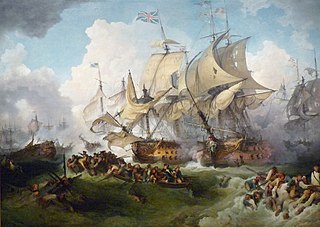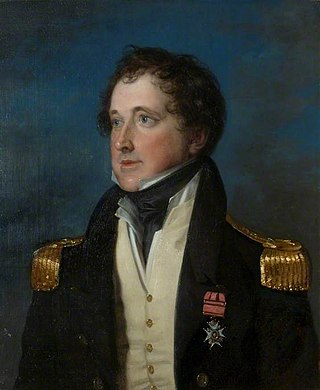
The Glorious First of June, also known as the Fourth Battle of Ushant, was the first and largest fleet action of the naval conflict between the Kingdom of Great Britain and the First French Republic during the French Revolutionary Wars.

Admiral of the Fleet Sir James Alexander Gordon, GCB was a Royal Navy officer. As a volunteer, he fought at the Battle of Groix, at the Battle of the Glorious First of June and at the Battle of Cape St Vincent during the French Revolutionary Wars and then, as a midshipman, served under Admiral Sir Horatio Nelson at the Battle of the Nile.

HMS Pegasus was a 28-gun Enterprise-class sixth rate. This frigate was launched in 1779 at Deptford and sold in 1816. Pegasus had a relatively uneventful career and is perhaps best known for the fact that her captain from 1786 to 1789 was Prince William Henry, the future King William IV. By 1811 Pegasus was a receiving ship at Chatham; she was sold in 1816.

Admiral Sir Henry Harvey KB was a long-serving officer of the British Royal Navy during the second half of the eighteenth century. Harvey participated in numerous naval operations and actions and especially distinguished himself at the Glorious First of June in command of HMS Ramillies. His career took him all over the world, particularly on the North American station and in the West Indies where he commanded numerous ships and, later in his career, squadrons during the course of three different wars. Harvey was a member of a distinguished naval family, his brother was killed in action in 1794, three of his sons entered the navy and one of them was later raised to admiral himself.
Admiral Sir Edward Harvey, was an officer of the Royal Navy during the French Revolutionary and Napoleonic Wars and continued in the service during the first half of the nineteenth century during which he participated in the bombardment of Acre in 1840. Harvey was the son of John Harvey an officer killed in action at the Glorious First of June and was related to several senior officers of the period in the distinguished Harvey family. A great-grandson, Francis Harvey won the Victoria Cross in 1916, sacrificing himself to save over 1,000 lives.

Admiral Sir Robert Waller Otway, 1st Baronet, GCB was a senior Royal Navy officer of the early nineteenth century who served extensively as a sea captain during the Napoleonic War and later supported the Brazilian cause during the Brazilian War of Independence. During his long service, Otway saw action across Europe and in North America and was rewarded in his retirement with a knighthood, baronetcy and position as a courtier within the Royal Household.
Captain Isaac Schomberg was a highly controversial officer of the British Royal Navy whose constant disputes with senior officers resulted in courts-martial, lawsuits and the eventual stagnation of his career. However, despite his contentious nature, Schomberg was a brave officer who gained distinction in several actions during the American Revolutionary and French Revolutionary Wars. He finished his career as a commissioner of the Navy and devoted most of the last fifteen years of his life to writing an influential history of naval operations in and around Britain.

Vice Admiral Sir William Johnstone Hope, GCB was a prominent and controversial British Royal Navy officer and politician in late eighteenth and early nineteenth century Britain, whose career experienced fleet actions, disputes with royalty, party politics and entry to both Russian and British orders of chivalry. A popular officer, Hope served with Nelson, Duncan and Lord Keith through several campaigns, making connections which enabled him to secure a lengthy political career after his retirement from the Royal Navy in 1804 due to ill-health. After 26 years in Parliament, Hope was largely inactive and instead served as a Lord of the Admiralty and commissioner of Greenwich Naval Hospital. Hope died in 1832 after 55 years of naval and political service and was buried in the family plot in Scotland.
Admiral Sir Robert Barlow GCB was a senior and distinguished officer of the British Royal Navy who saw extensive service in the American Revolutionary War, the French Revolutionary Wars and the Napoleonic Wars. He made his name in small ship actions, especially fighting French frigates, of which he captured three. In his later career Barlow served as comptroller of the Navy and was influential at the Admiralty right up to his death. Although born to a middle-class family, Barlow and his siblings made names for themselves and two of Barlow's daughters married into the naval aristocracy. His grandson, Robert Barlow, was a first-class cricketer and army officer.

William Brown was an officer of the British Royal Navy who served in increasingly senior positions during a long period from the American Revolutionary War, including the French Revolutionary War, and until the Napoleonic Wars. He began his naval career as a servant to Captain Philemon Pownoll in the frigate HMS Apollo and became a midshipman after two years. He then served on HMS Resolution with Lord Robert Manners and came home with him in HMS Andromache. He spent the next five years ashore in peacetime. After a brief time on HMS Bounty he was taken off by the First Lord and moved to HMS Ariel before Bounty sailed. He was then moved to HMS Leander, where he was commissioned by Admiral Peyton in 1788. He later captained a series of ships serving in the Mediterranean Sea, the North Sea, the Channel Fleet and then the Mediterranean, again with Lord St Vincent. He captained HMS Ajax in the Blockade of Brest and the Battle of Cape Finisterre and then at Cadiz at Nelson's personal request. After Trafalgar he had a series of shore postings as Dockyard Commissioner at Malta and Shearness before being made Commander in Chief of the Channel Islands and then Jamaica where he died.

Admiral Sir Herbert Sawyer KCB was an officer of the Royal Navy who saw service during the American Revolution, the French Revolutionary War, the War of 1812 and the Napoleonic Wars. He eventually rose to the rank of Admiral.
Admiral John Bazely was an experienced and highly respected officer of the British Royal Navy who served in three wars and saw numerous actions, notably during the American War of Independence. He first gained notice with the capture of the American brig USS Lexington in 1777, following which he was rapidly promoted and by 1779 was a post captain and fought in engagements under Augustus Keppel and George Rodney with some success. He later served in the Channel Fleet under Lord Howe and fought at the Glorious First of June, although his career stagnated during the French Revolutionary Wars and he was unemployed for the final decade of his life, despite his being "regarded with respect and gratitude by his compatriots at large".

Vice-Admiral Sir William Augustus Montagu was a senior officer of the British Royal Navy during the French Revolutionary and Napoleonic Wars who served in a number of sea battles and was also in command of the naval brigade in the brief land campaign to capture Île de France in 1810. During his service he was present at the capture of numerous French frigates and later served in the War of 1812. After the end of the Napoleonic Wars he remained in service and commanded several ships in the Mediterranean before he retired from active service in 1837. He remained a commissioned officer and later rose through the ranks to become a vice-admiral. For his services he was knighted in the Royal Guelphic Order and made a Companion of the Order of the Bath.

Admiral Sir James Hillyar KCB KCH was a prominent British Royal Navy officer of the early nineteenth century, who is best known for his service in the frigate HMS Phoebe during the Napoleonic Wars and the War of 1812. While in command of Phoebe, Hillyar was present at the Invasion of Ile de France in 1810, was heavily engaged at the Battle of Tamatave in 1811 and captured the USS Essex off Valparaíso in Chile in 1814. In addition, Hillyar was engaged in numerous other operations, his first battle occurring in 1781 off Boston. He remained in the Navy until his death in 1843, and was active at sea during the 1830s, commanding fleets in the North Sea and off Portugal. He was knighted twice and two of his sons later became full admirals, Charles Farrell Hillyar and Henry Shank Hillyar.
Admiral Sir Thomas Williams GCB was a senior British Royal Navy officer of the late eighteenth and early nineteenth centuries, who served in numerous theatres during the American Revolutionary War, French Revolutionary Wars and Napoleonic Wars. As a young officer he fought at a number of battles in the Caribbean and as a frigate captain he was knighted for his actions at the action of 8 June 1796 in which two French frigates were captured without a single man killed or wounded on Williams' ship HMS Unicorn. Later in his career, Williams commanded squadrons blockading the European coast and assisting the supply of the British Army during the Peninsula War.

Admiral of the Fleet Sir George Martin was an officer of the Royal Navy who saw service during the American War of Independence, and the French Revolutionary and Napoleonic Wars. During his long naval career he took part in several significant battles, for which he was awarded a number of honours and promotions; he commanded ships at Cape St Vincent and Cape Finisterre.
Admiral Sir Lawrence William Halsted GCB was an officer of the Royal Navy who served during the American War of Independence and the French Revolutionary and Napoleonic Wars.

Admiral of the Fleet William Peere Williams-Freeman was an officer in the Royal Navy. He saw action aboard as a junior officer at the Battle of Quiberon Bay during the Seven Years' War. He also took part, as captain of the fifth-rate HMS Venus, in the Battle of Rhode Island and then, as captain of the fifth-rate HMS Flora, in the second relief of Gibraltar during the American Revolutionary War.

The action of 12 May 1796 was a minor naval engagement during the French Revolutionary Wars between a squadron of British Royal Navy frigates and a frigate and four smaller ships of the Batavian Navy. The British squadron had been detached on the previous day from the British North Sea fleet under Admiral Adam Duncan, which was cruising off the Batavian fleet anchorage at the Texel, while the Batavian squadron was returning to the Netherlands from the Norwegian coast where it had been sheltering since suffering defeat at the action of 22 August 1795 the previous year. As the Batavian squadron neared the Batavian coast, the British squadron under Captain Lawrence Halstead attacked.
Admiral Thomas Le Marchant Gosselin was a British naval officer of the 18th and 19th centuries who received the patronage of senior officers such as Samuel Hood, 1st Viscount Hood and William Cornwallis. Gosselin joined the Royal Navy in 1778 and as a junior officer had extensive service in the American Revolution, including participating in the Battle of the Saintes in April 1782. Promoted to commander in April 1793, Gosselin took part in the Glorious First of June as commander of HMS Kingfisher. He was promoted to post-captain in July 1795 and took command of a variety of ships including most notably HMS Syren, HMS Latona, and HMS Audacious. Gosselin frequently served on blockade duties in the English Channel and on convoy duties to and from the West Indies.













